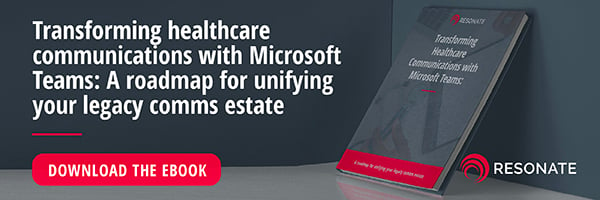How healthcare organisations can transform critical care with Microsoft Teams

When the world went into lockdown, Microsoft Teams was thrust into the limelight as an enabler of remote working. Enabling video conferencing from anywhere there was an internet connection, the platform gave organisations across a wide range of industries the opportunity to keep functioning.
Now we’re slowly coming out of the other side of the pandemic, people are beginning to realise that Microsoft Teams has so much more to offer than just video conferencing. Many healthcare organisations, for example, are now waking up to the fact that Teams can transform the way they deliver critical care for their patients.
Let’s take a look at some of the benefits of Teams for healthcare providers in a little more detail.
Secure messaging for the care team
With Teams chat, your clinicians and other employees can take advantage of secure messaging capabilities, including priority notifications and message delegation. This will enable your people to boost personal productivity and coordinate more efficiently with colleagues, both inside and outside of your organisation. They can also align activities of clinical personnel to deliver patient-centric care, applying the expertise of multidisciplinary teams and surfacing relevant insights. With smart cameras, image and annotation stay within the platforms and are not auto-stored to the care provider’s device.
Secure communications are vitally important for all healthcare organisations. Your team can send messages, capture and share images, and relay urgent information knowing that Microsoft Teams supports the enhanced security and compliance requirements for healthcare.
Built on the Microsoft 365 cloud, Microsoft Teams helps enable HIPAA compliance and also supports standards like Health Information Trust Alliance (HITRUST), Service Organization Controls (SOC) 1 and 2, and General Data Protection Regulation (GDPR).
Making the journey easier for patients
The beauty of Teams is that it seamlessly supports the whole patient journey. So, for example, you can bring up patient records within Teams, update them via Teams, record a video in Teams and then post it back to the patient record. Every step is smooth, fast and efficient.
Video conferencing provides a way for clinicians to deliver high-quality, personalised, and affordable consultations. Using the complete meetings platform in Microsoft Teams, combined with the new Bookings app in Teams, providers will be able to schedule, manage, and conduct virtual visits with patients.
Making healthcare workers more productive
With one Teams app and one enterprise smartphone, all desk phones, mobile phones, DECT devices, walkie talkies and pagers can be replaced, making life easier and communication more seamless for your entire workforce, from senior management to healthcare teams to administrative staff.
Teams also facilitates cross-department meetings with minimal disruption. Your people can conduct audio or video meetings across a range of devices with anyone inside or outside your organisation. That means your people can consult with remote clinicians—such as specialists—and engage in meetings between healthcare professionals across your entire network.
Simplifying day-to-day organisation
Working life for healthcare professionals becomes simpler in so many ways with Teams. Using the complete meetings platform, combined with the new Bookings app, providers can schedule, manage and conduct virtual visits with patients.
Team leaders can easily streamline the management of shift schedules and integrate them with leading workforce management systems such as AMiON. All key stakeholders in the organisation can keep track of the availability of beds, ventilators and other critical resources in real-time.
Optimise care team collaboration
The Teams platform strengthens communication and collaboration to help provide the best possible care. Improve the hand-off of patient information, streamline care with Microsoft Lists, and tailor Microsoft Teams with healthcare templates.
There are many benefits that make Microsoft Teams invaluable for healthcare providers, but arguably the most compelling of all is that it provides a solution for seamless collaboration across the entire organisation from clinicians and nurses to IT providers and administrators.
Keeping clinicians better connected
Teams enables clinicians to connect with the people and information they need whether it’s across their care team or health system, through a multidisciplinary team (MDT) meeting or while they’re on the go.
New use cases are emerging all the time. MedxNote, a Microsoft Teams Partner, is replacing their own chat app by surfacing their bots through Teams instead. That means clinicians can sign up to the MedXnote BOT to receive live patient notifications and results in Teams. A MedXnote pilot that ran at the University Hospital Southampton NHS FT has saved over 650 hours of clinical time by sending out 2,440 messages via chat to the clinician’s mobiles.
Enabling fewer nurses to do more
With the long-term shortage of skilled nurses, many healthcare organisations are using fewer nurses to treat more patients. To make this equation feasible, nurses need to be equipped with clinical automation capabilities, such as vitals documentation via PDAs or smartphones, critical to the nurse-patient relationship.
Teams can help here by orchestrating resources and care across departments, digitising clinical workflows, and enabling coordinated care with instant access to people and patient information.
Helping IT professionals and administrators do a better job
IT professionals can use Teams to give clinicians and staff a secure and compliant way to communicate and collaborate with built-in manageability features like eDiscovery, audit reports, and data loss prevention.
Keeping track of everything is no easy task. Each interaction with today’s health system creates a new data point. These data points are often spread across multiple records, with important information potentially hidden in siloes. Teams enables a seamless and better-connected healthcare system with information instantly available for all the key stakeholders. This capability allows administrators to serve healthcare teams and patients more efficiently.
Administrators can also use Teams to securely communicate with clinicians and all hospital staff, sharing important announcements across the organisation, and collaborating effectively in one place.
Introducing the Resonate Teams for Health package
Of course, Teams can’t do everything discussed here out of the box, but with Resonate’s Teams for Health package added in you can help your workgroups and individual care staff access all the benefits of Microsoft Teams, quickly and efficiently.
At Resonate, we help organisations in the healthcare sector increase their operational agility and serve their patients better by leveraging the investment in O365 and Microsoft Teams. These platforms provide a single interface, such as a mobile phone, for communication, collaboration and access to key data sources. Talk to us about how Teams can transform your healthcare organisation today.
More like this
 Empowering Frontline and On-The-Move Workers with Microsoft Technology - 1
Empowering Frontline and On-The-Move Workers with Microsoft Technology - 1
 A message from our CEO - 2
A message from our CEO - 2
 Press Release - Resonate is now an SCC business - 3
Press Release - Resonate is now an SCC business - 3

